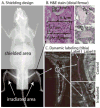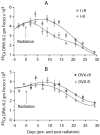The influence of therapeutic radiation on the patterns of bone remodeling in ovary-intact and ovariectomized mice
- PMID: 23314741
- PMCID: PMC3595353
- DOI: 10.1007/s00223-012-9688-0
The influence of therapeutic radiation on the patterns of bone remodeling in ovary-intact and ovariectomized mice
Abstract
Our purpose was to characterize changes in bone remodeling associated with localized radiation that models therapeutic cancer treatment in ovary-intact (I) and ovariectomized (OVX) mice and to evaluate the influence of radiation on the pattern of bone mineral remodeling. Young adult, female BALB/c mice, I and OVX, were used (n = 71). All mice were intravenously injected with 15 μCi (45)Ca. Thirty days post-(45)Ca administration, the hind limbs of 17 mice were exposed to a single dose of 16 Gy radiation (R). The time course of (45)Ca excretion, serum CTx and osteocalcin markers, and cancellous bone volume fraction (BV/TV) and cortical thickness (Ct.Th) of the distal femur were assayed. Cellular activity and dynamic histomorphometry were performed. Irradiation resulted in rapid increases in fecal (45)Ca excretion compared to control groups, indicating increased bone remodeling. CTx increased rapidly after irradiation, followed by an increase in osteocalcin concentration. BV/TV decreased in the I mice following irradiation. Ct.Th increased in the OVX groups following irradiation. I+R mice exhibited diminished osteoblast surface, osteoclast number, and mineral apposition. Our murine model showed the systemic effects (via (45)Ca excretion) and local effects (via bone microarchitecture and surface activity) of clinically relevant, therapeutic radiation exposure. The I and OVX murine models have similar (45)Ca excretion but different bone microarchitectural responses. The (45)Ca assay effectively indicates the onset and rate of systemic bone mineral remodeling, providing real-time assessment of changes in bone histomorphometric parameters. Monitoring bone health via a bone mineral marker may help to identify the appropriate time for clinical intervention to preserve skeletal integrity.
Conflict of interest statement
The authors have stated that they have no conflict of interest.
Figures






Similar articles
-
Skeletal remodeling following clinically relevant radiation-induced bone damage treated with zoledronic acid.Calcif Tissue Int. 2012 Jan;90(1):40-9. doi: 10.1007/s00223-011-9547-4. Epub 2011 Nov 15. Calcif Tissue Int. 2012. PMID: 22083107
-
The influence of therapeutic radiation on the patterns of bone marrow in ovary-intact and ovariectomized mice.PLoS One. 2012;7(8):e42668. doi: 10.1371/journal.pone.0042668. Epub 2012 Aug 6. PLoS One. 2012. PMID: 22880075 Free PMC article.
-
Effects of a new selective estrogen receptor modulator (MDL 103,323) on cancellous and cortical bone in ovariectomized ewes: a biochemical, histomorphometric, and densitometric study.J Bone Miner Res. 2001 Jan;16(1):89-96. doi: 10.1359/jbmr.2001.16.1.89. J Bone Miner Res. 2001. PMID: 11149494
-
Evaluation of the skeletal effects of combined mild dietary calcium restriction and ovariectomy in Sinclair S-1 minipigs: a pilot study.J Bone Miner Res. 1993 Nov;8(11):1311-21. doi: 10.1002/jbmr.5650081106. J Bone Miner Res. 1993. PMID: 8266823
-
Systematic Review on Multilevel Analysis of Radiation Effects on Bone Microarchitecture.Biomed Res Int. 2022 Jun 6;2022:9890633. doi: 10.1155/2022/9890633. eCollection 2022. Biomed Res Int. 2022. PMID: 35782085 Free PMC article.
Cited by
-
POU Class 2 Homeobox Associating Factor 1, as a Hub Candidate Gene in OP, Relieves Osteoblast Apoptosis.Appl Biochem Biotechnol. 2024 Sep;196(9):6072-6096. doi: 10.1007/s12010-023-04833-y. Epub 2024 Jan 6. Appl Biochem Biotechnol. 2024. PMID: 38183606
-
Use of dual-energy computed tomography to measure skeletal-wide marrow composition and cancellous bone mineral density.J Bone Miner Metab. 2017 Jul;35(4):428-436. doi: 10.1007/s00774-016-0796-1. Epub 2016 Dec 9. J Bone Miner Metab. 2017. PMID: 27942979 Free PMC article.
-
Effects of radiation on bone.Curr Osteoporos Rep. 2013 Dec;11(4):299-304. doi: 10.1007/s11914-013-0174-z. Curr Osteoporos Rep. 2013. PMID: 24057133 Review.
-
A dual-radioisotope hybrid whole-body micro-positron emission tomography/computed tomography system reveals functional heterogeneity and early local and systemic changes following targeted radiation to the murine caudal skeleton.Calcif Tissue Int. 2014 May;94(5):544-52. doi: 10.1007/s00223-014-9839-6. Epub 2014 Feb 23. Calcif Tissue Int. 2014. PMID: 24562595 Free PMC article.
-
Influence of radiation exposure pattern on the bone injury and osteoclastogenesis in a rat model.Int J Mol Med. 2019 Dec;44(6):2265-2275. doi: 10.3892/ijmm.2019.4369. Epub 2019 Oct 11. Int J Mol Med. 2019. PMID: 31638191 Free PMC article.
References
-
- Guise T. Bone loss and fracture risk associated with cancer therapy. The Oncologist. 2006;11:1121–1131. - PubMed
-
- Chen Z, Maricic M, Bassford T, Pettinger M, Ritenbaugh C, Lopez A, Barad D, Gass M, LeBoff M. Fracture risk among breast cancer survivors: Results from the Women’s Health Initiative Observational Study. Archives of Internal Medicine. 2005;165:552. - PubMed
-
- Baxter N, Habermann E, Tepper J, Durham S, Virnig B. Risk of pelvic fractures in older women following pelvic irradiation. Am Med Assoc. 2005:2587–2593. - PubMed
-
- Garnero P. Markers of bone turnover for the prediction of fracture risk. Osteoporos Int. 2000;11(Suppl 6):S55–65. - PubMed
-
- Johnell O, Oden A, De Laet C, Garnero P, Delmas P, Kanis J. Biochemical indices of bone turnover and the assessment of fracture probability. Osteoporosis International. 2002;13:523–526. - PubMed
Publication types
MeSH terms
Substances
Grants and funding
LinkOut - more resources
Full Text Sources
Other Literature Sources
Medical

